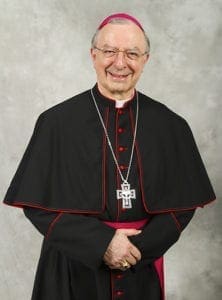A shorthand for how the faith is lived
By BISHOP JOEL M. KONZEN, S.M. | Published May 18, 2021 | En Español
The letters after Archbishop Hartmayer’s name (OFM Conv.) and after my name (S.M.) are not academic but religious references. In his case, the abbreviation tells that he is a member of the Conventual Franciscans, one of several large groups of Franciscan Friars. In my case, the designation says that I am a member of the Society of Mary—Marists.

Bishop Joel M. Konzen, SM
These letters are important to us. They indicate that, before we were ever ordained priests, we took vows as consecrated religious. Throughout the world, there are diocesan priests, who are the majority, and there are priests who are members of religious orders. The same applies to bishops—more were diocesan priests, and some smaller number, such as Archbishop Hartmayer and me, were vowed members of religious congregations.
The letters function like an additional surname. They state the religious family that we belong to. You often see other initials such as these—SJ for Jesuits, LC for Legionaries of Christ, OP for Dominicans, and so on. The same is true for religious sisters and brothers in the church—RSM for Sisters of Mercy, CSJ for Sisters of St. Joseph, FSC for the De La Salle Christian Brothers.
In addition to simply telling that a religious is a member of that particular order, the letters indicate that these members also are deeply formed in the unique spirituality of the congregation. You hear religious describe their heritage and their prayer tradition as “Benedictine spirituality” or “Fransalian spirituality.” If you ask, they will explain the special features of this spirituality and how these developed from the founding of the group. This spirituality and ministerial or prayer focus are often referred to as the “charism” of the order, that mission and defining spiritual character that sets the congregation apart from another in the church.
It is one of the great riches of the Catholic Church that diocesan clergy, including ordained deacons, cooperate with religious order members and laity in bringing a wealth of varied spiritual and ministry traditions to their activities in the church. To the outsider, we may appear to be of a single stripe as Catholics, and indeed we want to be unified in our belief and in our loyalty to the Church of Rome. But, on closer examination, we are truly multifaceted. The many expressions of spiritual reality that comprise the Catholic Church produce generous and heroic individuals, bound together in their devotion to revealed truth but distinctive in the way that they were influenced by one of the many traditions that shape one’s living of the faith.
When you see the letters after someone’s name in the church, you know that they once were novices in their congregation—that is, spent a year or more learning about that group’s tradition. You will also know that they took temporary and then final or perpetual vows—usually vows of poverty, chastity, and obedience. And you will know that the aim of that religious congregation is to imprint their activity in the church with the special character that embodies the group’s tradition in prayer and ministry.
There are several types of religious congregations: contemplative, such as cloistered sisters; active or apostolic, such as the Redemptorists and the Daughters of Charity; friars, such as Franciscans and Dominicans; canons, such as the Augustinians, and monks or nuns (properly speaking, not all sisters are nuns), such as Trappists and Benedictines. So, the letters are a kind of shorthand, a signal that gives an abbreviated supplement to the individual’s identity in the church.
All of us whose lives are devoted to service in the church, whether diocesan or members of religious congregations, or lay Catholics, appreciate the prayers that are offered daily for the strengthening of and perseverance in our vocation.

